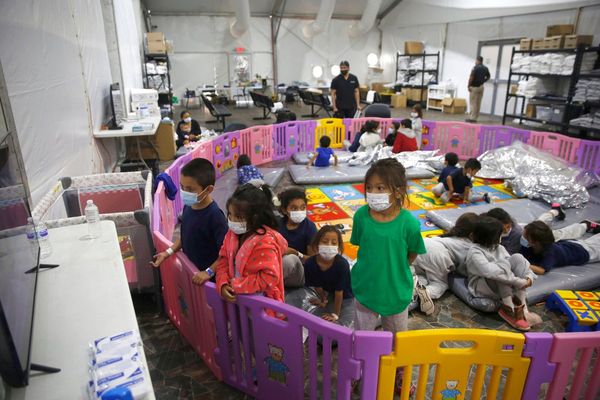
A woman wears a long thermometer on a hook hanging from her ear, her chin upturned and eyes gently closed, in a photograph taken by the artist Man Ray around 1920, not long after the influenza pandemic of 1918.
One hundred years later, another woman hangs on her ear a negative Covid-19 rapid test, decorated with rhinestones and a dangling gold heart. This photo was taken in late 2021.
These are the images — which have nothing and everything to do with the designer Elsa Schiaparelli — that came to mind while walking through a new exhibition dedicated to the Italian-born couturière, who founded her label in 1927.
Schiaparelli was a designer who put things where they should not have been: hands on belts, aspirin on necklaces, cicadas on buttons, claws on the fingertips of gloves. But these “little jokes,” as The New Yorker wrote of her style in 1932, “turned out to be big influences.” (The jokes were also, at times, so practical that they became less funny: During Prohibition, Schiaparelli sold an evening coat with a bustle able to conceal a flask; later, she made a jumpsuit to wear in air raid shelters.)
But the designer has also developed a reputation for being “underrated,” said Olivier Gabet, director of the Musée des Arts Décoratifs.
“You understand the invisibility of women artists with the case of Schiaparelli,” Mr. Gabet said. Though a handful of museums have devoted major fashion exhibitions to her in the past 20 years, Schiaparelli is less recognized within the history of Surrealist art, he said, despite close associations with Salvador Dalí, Jean Cocteau and Man Ray, whose work is arranged beside hers in the new exhibition.
In fashion, “everybody helped themselves” to her work following the closure of her couture house in 1954, Mr. Gabet said. Schiaparelli turned newspaper clippings into fabric before John Galliano, and a woman’s torso into a perfume bottle before Jean Paul Gaultier. Even today, with her revived label finding a new audience under creative director Daniel Roseberry, her name is not as well known as those of the men she influenced, like Yves Saint Laurent and Hubert de Givenchy.
This exhibition arrives as another attempt to correct that: not just to impress viewers with her original creations and artistic connections — plus a fair amount of Mr. Roseberry’s recent work — but to implant in them the knowledge of how far her curious mind and angular arms have reached into modern fashion. Look around and Schiap, as she was known, is everywhere. Even in a pair of bedazzled antigen test earrings, made nearly 50 years after her death, by a Spanish college student with a D.I.Y. hobby.
The Paris exhibition plays the hits.
Encased in glass is a black Schiaparelli hat worn like an upside-down high-heel shoe. Nearby is a version of the off-white silk organza dress worn by Wallis Simpson for Vogue in 1937, the same year she married the former King Edward VIII; an enormous lobster lolls down the front and back of the skirt. Both pieces originally were designed in collaboration with Dalí.
There is also an assortment of knits that made Schiaparelli a star: One of her earliest designs was a sweater printed with a trompe l’oeil bow around its neck that she first wore to what she called a “smart lunch” in Paris. “Sweater-minded” women, she wrote in her 1954 autobiography, “fell on me like birds of prey,” among them a buyer from a New York department store.
But it is not just Schiaparelli’s surreal style signatures that continue to resurface in fashion (like Marc Jacobs referencing those knits in 2016, as just one example). The legends around her also resonate. In her autobiography, Schiaparelli wrote of being an “ugly” child who planted seeds in her throat, ears and mouth, in hopes of growing “a face covered with flowers like a heavenly garden.” (Surviving near-suffocation, she later designed a summer dress covered in fabric appliqués resembling seed packets.)
The image calls to mind the transformative shrub makeup and floor-length capes seen in Thom Browne’s spring 2022 show. Or, more recently, the Loewe collection of coats, jeans and sneakers covered in real sprouted grass by Jonathan Anderson, its creative director, and the designer Paula Ulargui Escalona.
The way Schiaparelli presented her work, too, is still relevant. She was an early adopter of themed collections, choosing subjects like music, astrology, the pagan (making women look like Botticelli paintings) and the circus.
Walking through the exhibition a few days before its opening, Mr. Gabet was thinking about how young audiences might respond: “I’m not sure the name Elsa Schiaparelli is so familiar to them,” he said. “If they know the name, it’s through Daniel’s work.”
In text accompanying the Paris exhibition, Mr. Roseberry said he had kept Schiaparelli’s signatures at “arm’s length.”
“I kind of had this image of her passing the torch,” he said. “I don’t think she would be interested in seeing her work reissued over and over again, a century later. I think she would be championing the new, and I can only hope that that would include me.”
The New York Times







